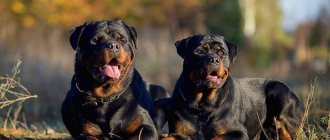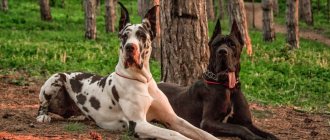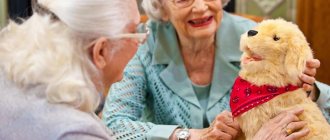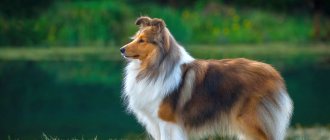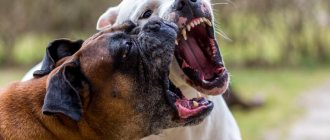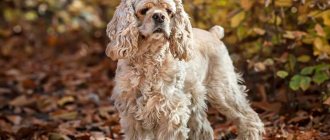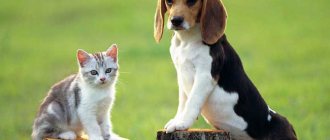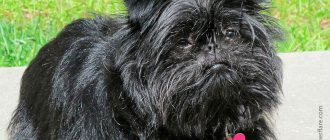What determines a dog's character?
There are suggestions that the character of a “shaggy” friend is formed from genetically laid down prerequisites or, on the contrary, it is the result of upbringing and training. The conditions in which the dog lived and was raised are also of great importance. After all, if she grew up in fear and oppression, then she is unlikely to be affectionate and cheerful in communication and a devoted friend to her owner. When purchasing a puppy, you can predict in advance how your four-legged friend will grow up.
Terrier Personality Traits
Known for their playful and cheerful disposition, terriers come in a variety of shapes and sizes. They have a strong possessiveness and will bark at anyone who comes near their home or family. They also like to hunt small animals (such as foxes or rats) and dig in search of their prey.
Terriers are a good choice for patient but energetic owners. Terriers love to exercise because it's a game for them. If you can match the energy, you will definitely become best friends with them.
The breeds that belong to the terrier group are: Jack Russell Terrier, Rat Terrier, Miniature Schnauzer, Scottish Terrier, Staffordshire Terrier and West Highland White Terrier.
First meeting
If you remember how you chose a puppy, you might wonder why preference was given to him? After all, there were probably several of them that were exactly the same, cute and funny. From the first days of a puppies' life, it is possible to determine which of them will be the dominant leader and which will be more passive and docile. As a rule, already during the first meeting we intuitively feel which of the proposed puppies we will take with us. But it has also been observed that certain dog breeds have similar character traits that are passed on from generation to generation. Heredity is the basis on which a pet’s individuality is based and the necessary qualities and character traits are developed.
Shepherd
People who keep dogs belonging to guard and herding breeds are distinguished by their strong character and determination. They do not like to waste time and do not accept anyone living at their expense. Many may not like the company of a person who loves order and does not understand hints, however, shepherd lovers are devoted family men. They know how to adapt to their partner without losing self-esteem.
Related article: Remedy against laziness
The main drawback of shepherd dog owners: an inferiority complex may be hidden behind external rudeness.
Image by sabsykorova from Pixabay
The character and behavior of dogs depending on their purpose
When getting a dog, you need to consider the pet’s compatibility with your character and lifestyle. Knowing the breed, you can predict how the dog will behave in the future, although a lot depends on upbringing. Dogs are divided into hunting, decorative, herding, service and companion dogs. The purpose of each of them could not but affect the character developed over centuries. Directed selection has led to animals acquiring certain behavioral traits. For example, service dogs will not be able to hunt, and decorative dogs will not be able to herd herds. Specialized dogs will behave the same way in similar situations.
Thus, among all breeds, companion dogs are the most flexible in behavior. Such a dog can equally well become a bloodhound, a hunter, a shepherd or a watchman. Communication with such animals can be vibrant and interesting, although a little unpredictable. For example, schnauzers are prominent representatives of this group. They are cheerful, smart and adequate in various situations. Schnauzers love children very much, do not make noise, are smart, and alert. These animals are a real find for the family: they are a friend and a watchman, and are endowed with many other service qualities.
Decorative dogs also have their own functions. They not only play the role of a pet, but also reflect the personality of their owner. At all times, they were valued for their unusual growth, color, and body shape. Their only vocation was to entertain the owners. Small dogs are sometimes some semblance of a living toy. This has led to the fact that pets of this group are not able to survive in extreme conditions, but time has made its correction, and sometimes it is difficult to understand who is boss. Dogs with an established genotype, the Chihuahua, still have a more stable psyche. This is one of the smallest breeds in the world. They are distinguished from other decorative dogs by their balance. These little ones are proud and beautiful, very active and cheerful.
They are easy to train. They often participate in all the affairs of the owner, keeping company on a walk, in the office, on a visit, etc. They are friendly and get along with other animals. This is not just a dog, but a little friend with a big heart! In any case, decorative dogs evoke the same feeling of tenderness as small children. They should also have their own personal corner in the house with comfortable beds, furniture, and a carrying bag.
Hunting breeds have evolved through the selection of more efficient ones. This is where the characteristics of the breed of this group arose. They are distinguished by their passion for searching and pursuing prey and the display of a certain intelligence. As pets, they require more physical activity, you need to walk with them longer, and being quite independent, they can run away and get lost. For example, small cats may show inappropriate aggressiveness towards other animals. If large representatives are more phlegmatic and therefore more intelligent, then medium-sized animals are a little unbalanced (Staffordshire terriers, bulldogs). Although they are friendly to people. The Staffordshire Terrier is a strong dog that embodies strength, energy and power. These dogs have a cheerful disposition, but they are not fussy. They only give their voice for a good reason, but they love to play with anyone who wants to. These animals are able to anticipate serious situations, but do not lose their cool. They will not growl or bark unless necessary. By carefully observing the owner, they feel his mood and “adjust” their own behavior according to it.
Herding breeds are good-natured and can serve as “nannies” for children. They are quite smart and quick-witted. But some qualities manifest themselves negatively. For example, when they try to jealously control the behavior and movements of family members. This can be eliminated by timely shaping of behavior. Let's look at one of the herding breed dogs - the German Shepherd. This is a balanced animal, smart, agile, and capable of training.
Service dogs kept in apartments tend to be aggressive and display reflexes of protecting the territory, food, and owner, which is unacceptable in urban conditions. In this case, to relieve excessive aggression, you can resort to the help of sedative veterinary medications, widely available in veterinary clinics. Shar Peis are one of the representatives of the category of service dogs, smart, independent. They are very sociable and are considered good family dogs, loyal to their owner.
How to determine a puppy's character
You can determine the character of your future pet by observing it. The easiest way to do this is with a stimulus (for example, a squeaking toy).
- A choleric person will have the most vivid emotional reaction: he will immediately run to the irritant and, most likely, will start barking at him.
- A sanguine person will be more reserved.
- A phlegmatic person will not show zeal, will not run towards the irritant, but will only look at him or calmly approach him.
- The melancholic person will be afraid or treat it with caution, but will not approach.
To determine a puppy's tendency to lead, you can watch his interactions with other puppies.
The easiest way to determine a puppy’s character is by looking at his reaction during the following actions:
- when a person puts a puppy on its back,
- when the puppy is held in the air,
- when they stroke him (especially on the back and head,
- when he is called to come.
If a puppy behaves completely differently in different situations, then it may turn out to be unpredictable. A puppy that is afraid of everything and reacts exclusively negatively will also be very difficult to train. The best reaction is calm and friendliness; mild protests are possible (for example, if a person lifts a puppy into the air).
Ways to determine a dog's character
To determine character, the animal is tested for its reaction to danger by simulating an attack. They also look at the reaction upon contact with other animals or people. After the tests, pets are divided into good-natured, balanced, phlegmatic, aggressive, cowardly, evil and with an unstable psyche.
Thus, the character of a dog largely depends not only on its breed, but also on its upbringing. Each breed has its own specific characteristics that the owner should be aware of, just as individual characteristics that influence the success of training must be taken into account.
Return to list of articles
Dachshund
The owner of a dachshund can be described in three words: carefree, non-conflict, sensitive. He trusts everyone and is ready to rush to the aid of even a stranger. He does not suffer from loneliness, but due to boredom he spends a lot of time in society.
The main disadvantage of dachshund lovers: they want to please everyone, they are seducers who do not have a timid character.
Image by AnjaGh from Pixabay
Where do dogs' habits come from?
If the dog owner does not “explain” acceptable behavior to his pet through training, then the dog tries to learn about the world around him on his own, through trial and error. A significant part of behavioral problems goes away as the pet grows up and learns various rules or requirements. Good and bad habits largely depend on the dog's temperament type.
Good habits
Sanguine dogs have the most comfortable type of temperament to keep. Such pets have a calm disposition, quickly adapt to any changes in the environment, and are also characterized by an even attitude towards other animals and children. A sanguine dog is able to cope well with stress and has a very balanced nervous system.
Choleric dogs have higher nervous excitability than pets of the sanguine type. Such animals are extremely active, capable of reacting almost instantly to any external stimuli. As a rule, a choleric dog is difficult to raise, due to its irrepressible energy and insufficient level of concentration. Animals with a choleric temperament are recommended for very active people.
Bad habits
Phlegmatic dogs have a calm and balanced character, are able to withstand significant stress and are good with children, but they are difficult to train and often have unwanted habits. Rare psycho-emotional states include melancholic dogs, which are characterized by timidity and indecisiveness, and also poorly adapt to external factors.
It should be noted that the culling of dogs with bad habits was, as a rule, carried out by specialists, including breeders and trainers, who excluded unsuitable individuals at the earliest stage of development, in puppyhood.
Return to content
Dalmatian
Breeders of such dogs constantly need the attention of others. Owners of spotted dogs do not like loneliness, but even the closest people do not know what is really going on in their souls.
The main disadvantage of Dalmatian owners: they are often unhappy with everything.
Image by Yama Zsuzsanna Márkus from Pixabay
Puppy's reaction to testing
a – he immediately runs up with his tail raised and starts jumping and tries to play with you, biting your hands; b – runs up with his tail raised and starts scratching you with his paws; c – runs up immediately, but with his tail lowered; d – runs up after some doubts and hesitations with a confused and embarrassed look; d – doesn’t run up at all.
Second test
is carried out on the ability to follow a person. Stand next to the puppy for a while, then begin to move away from him with a calm step.
Puppy's reaction:
a – he immediately runs after you with his tail raised, has fun and tries to grab your legs; b – immediately runs alongside, tail raised; c – immediately runs after you, but timidly and with his tail lowered; d – timidly follows you, the tail is lowered, and the puppy himself is confused; d – does not follow you at all or goes in the other direction.
The third test reveals the puppy's degree of compliance with coercion, as well as its reaction to physical or psychological coercion. Turn the puppy over onto his back and hold him in this position for about 25-30 seconds.
Working breed puppy reaction
a – shows a sharp protest, attempts to wriggle out and free themselves immediately begin; b – actively protests, trying to slip out from under the hand; c – begins to protest, but quickly calms down; d – does not protest, tries to play and lick hands; d – gets scared and lies motionless.
Fourth test
e shows the puppy's reaction to social dominance. Start petting the resting puppy's back.
Puppy behavior:
a – rejoices, actively begins to play, jump, lick hands; b – starts jumping, hitting with its paws, licking its hands; c – turns to you and licks your hands; d – rolls over onto his back and licks his hands; d – runs away and doesn’t want to come closer.
The fifth test reveals the reaction to complete dominance. Take the puppy under his tummy with both hands and hold him there for about 30-40 seconds.
Possible puppy reaction:
a – immediately begins to actively protest, growls, bites and tries to escape; b – struggles vigorously, but does not bite; c – after a short protest, he calms down and begins to lick his hands; d – behaves calmly, licks hands; d – scared and tense.
Analysis of test results
The character of the puppy and the prognosis of its behavior during upbringing are determined by the test results by counting the number of reactions shown (a, b, c, d, e) corresponding to a certain type.
The first type of puppy character is a guard
If the puppy showed a reaction of more than two a's in combination with several b's, then he will try to dominate in almost all situations, and may also show aggression in response to unpleasant treatment from both his relatives and people. A dog with such a character is not recommended for families with small children; its proper upbringing requires an experienced trainer who can always remain calm and not use physical punishment. It is optimal to use such a dog for protective and security work.
The second type of puppy temperament is for a large family
A reaction of more than two b indicates that the puppy has a tendency towards calm leadership based on self-confidence. Such dogs lend themselves well to almost any type of training and perform very successfully in a variety of competitions. A German Shepherd with this type of character is quite obedient and suitable for families with elderly people and small children. She will be a good friend, with whom you feel comfortable in any environment.
The third type of puppy character is highly adapted
If the result is more than three v, then the dog can adapt to any conditions; it has a very high degree of adaptation. A German Shepherd with such a character is suitable for families of any composition. Its only drawback is that it may cause difficulties in developing protective and security skills.
The fourth type of puppy character BUT - train with love
With a result of more than two g, especially in the presence of d, it can be argued that the puppy has a tendency to obey, but for a calm and confident existence in the family he will need constant contact with the owner and frequent encouragement. You need to raise such a dog with affection, showing love and sensitivity. A German Shepherd with a similar character can show aggression and bite only in response to poor, cruel treatment.
The fifth type of German Shepherd puppy temperament is difficult to train.
In a case similar to the previous one, but with d for the fourth test, the puppy will need special training, since he may have difficulty getting used to living with people. If a and b are also present in the results, then the dog may attack due to fear of punishment. When raising her, constant monitoring is necessary.
If c and d are present, the puppy’s character will be unbalanced, and the reaction to stressful situations will be confusion and panic. Such a dog can pose a danger to children. It will be quite difficult to train her.
The sixth type of temperament is only for experienced and patient breeders
More than two d in the test results indicate that it is better not to adopt a puppy, since it will be extremely difficult to raise him. A dog with such a character does not respond well to any measures of influence and can bite in stressful situations. Only a very experienced trainer can cope with it.
The seventh personality type of a German Shepherd puppy is unpredictable.
If the results contain both a and d, then the puppy’s character will become completely unpredictable with age. His behavior will be more or less stable only in a familiar and familiar environment. It is not advisable to adopt such a puppy.
Doberman
People who have such pets are authoritarian individuals with a difficult character. People around them don’t always understand them, but it seems that the owners of graceful dogs like it. They like intrigue. In general, these are passionate natures, with whom there is never a dull moment.
Related article: What do smells signal?
The main disadvantages of Doberman lovers: they are aggressive and very jealous.
Image by Jan Steiner from Pixabay
